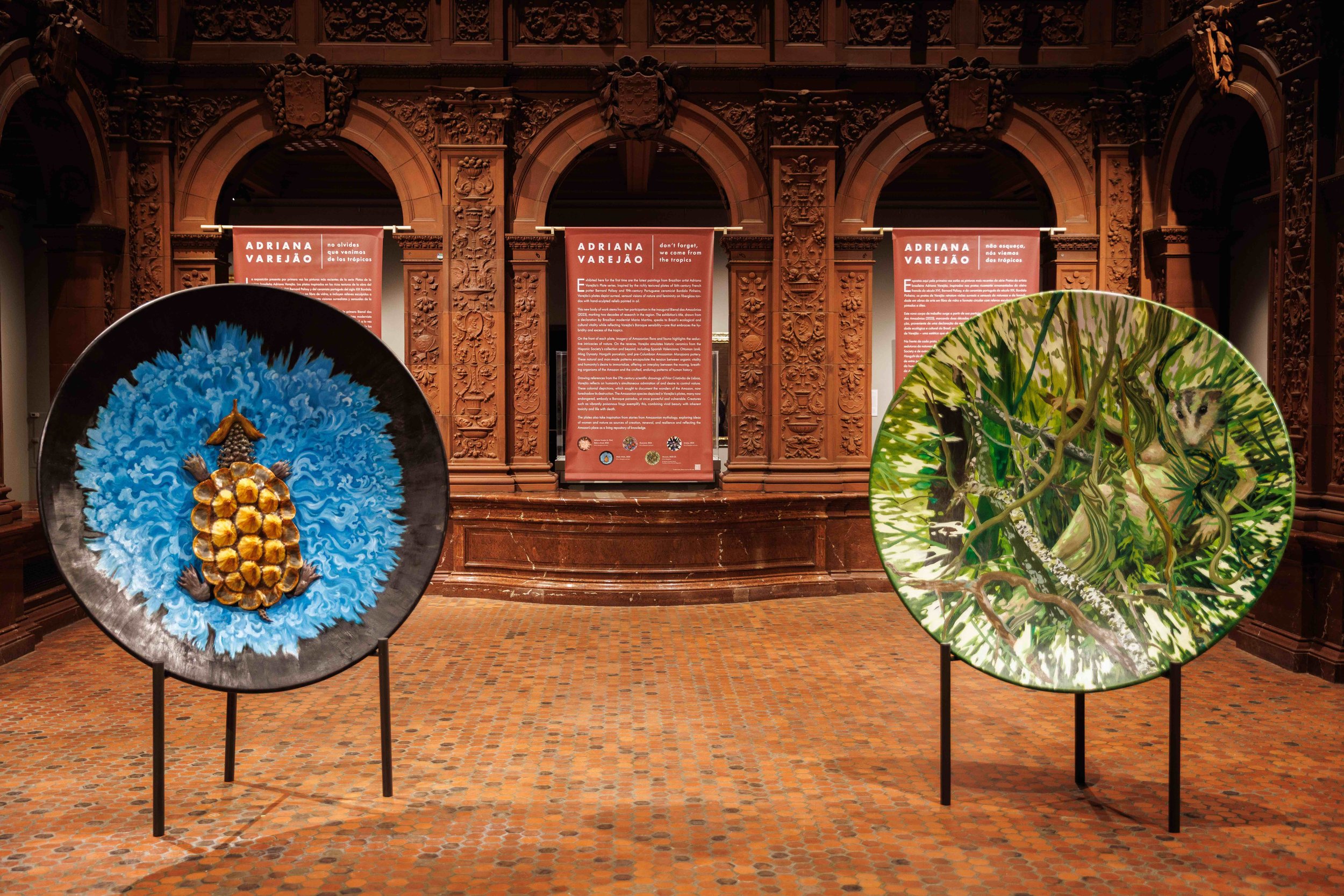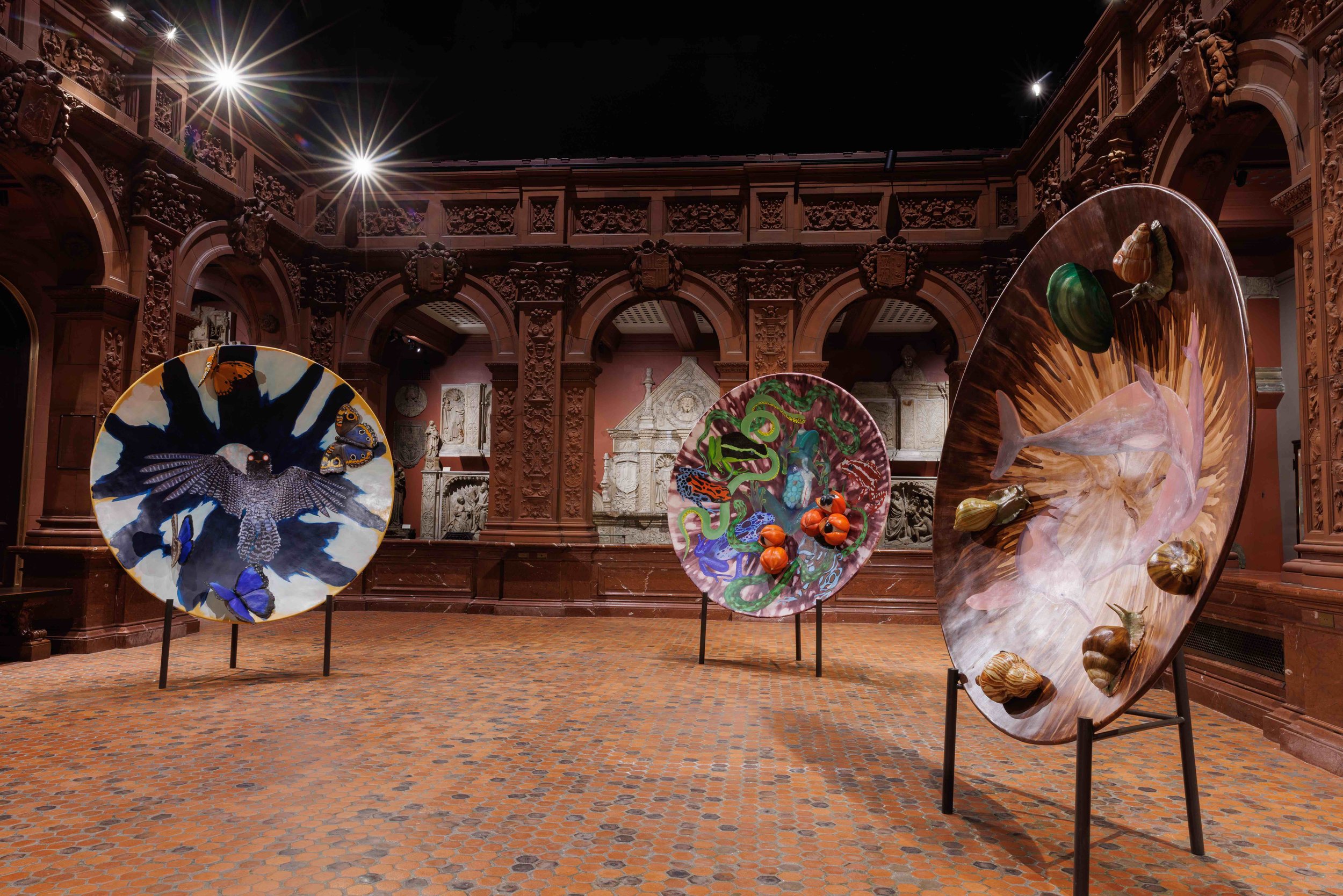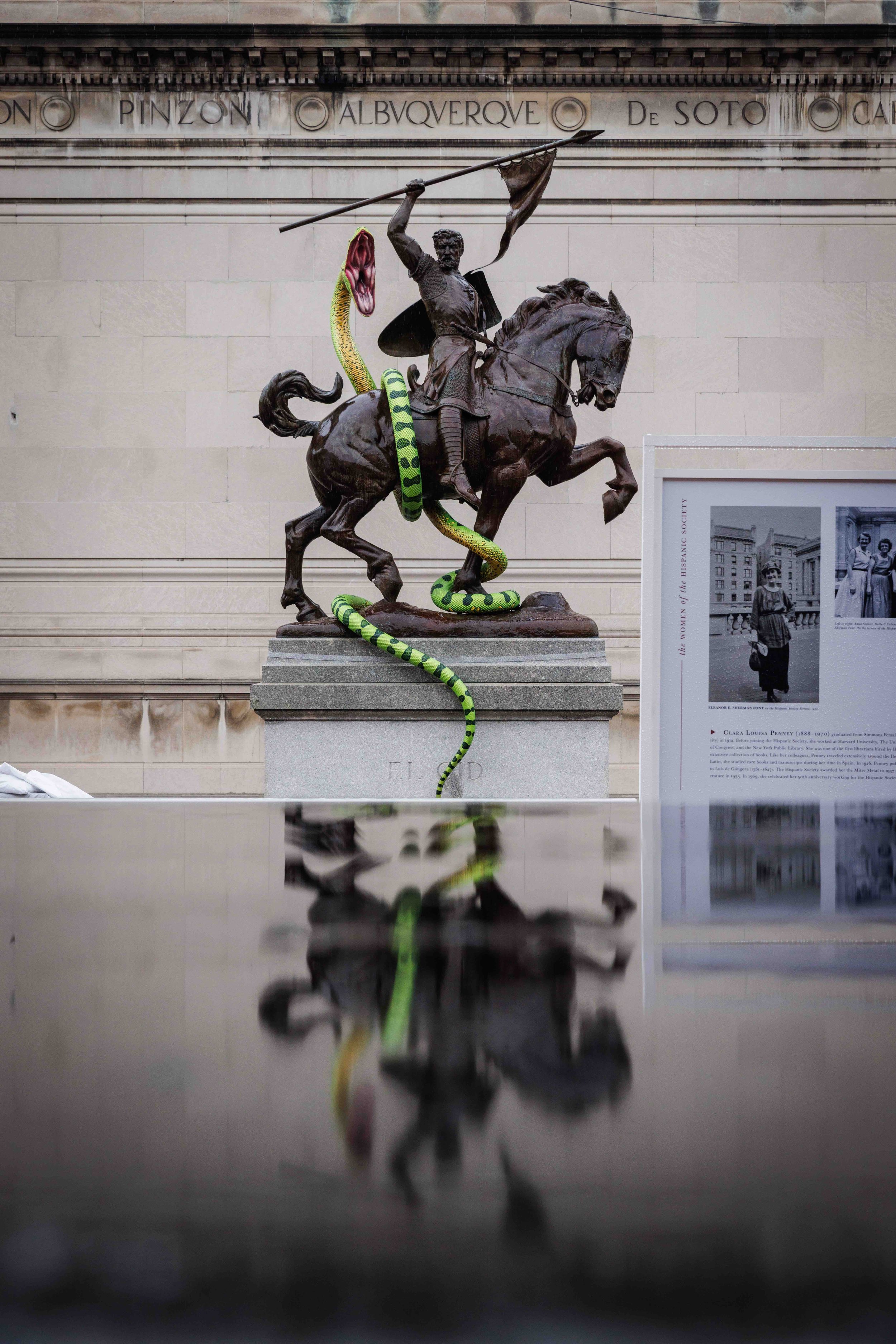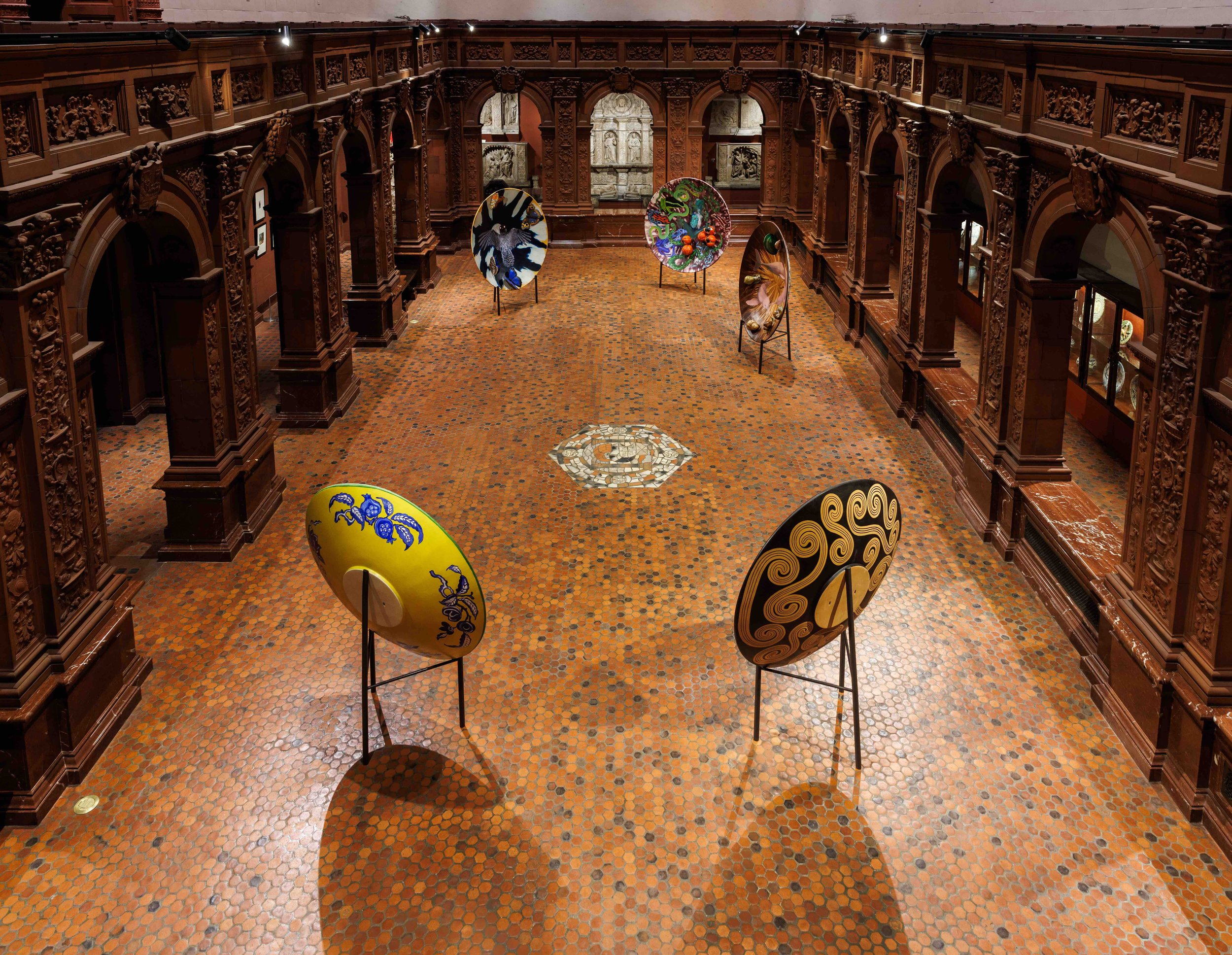Of Snakes and Mirrors
What if nature, transfigured by a mirror, redirected its gaze at us, human beasts?
By Bernardo José de Souza
What if nature, transfigured by a mirror, redirected its gaze at us, human beasts?
Bernardo José de Souza • 7/1/25
Adriana Varejão: Don’t Forget, We Come from the Tropics, The Hispanic Society Museum & Library, New York, March–June 2025
-
On Site is The Curatorial’s section in which writers review exhibitions from a curatorial perspective—not an art review, a curatorial review. This is also a showcase for master’s degree students in the MA Curatorial Practice program at the School of Visual Arts (the home of the journal) to publish as part of the program—though others are welcome to write for On Site as well.
In this review, Bernardo José de Souza examines Don’t Forget, We Come from the Tropics, Adriana Varejão’s exhibition at the Hispanic Society Museum & Library. Engaging with colonial histories, Indigenous cosmologies, and the material language of ceramics, the show challenges Western perceptions of nature and subjectivity. Varejão’s large sculptural plates operate as both mirrors and speculative worlds, prompting a reversal of the gaze. The exhibition is conceptually layered and visually immersive, offering a critical reflection on power, perception, and the role of the museum.
Adriana Varejão: Don’t Forget, We Come from the Tropics exhibition view at the Hispanic Society of America. Image courtesy Gagosian.
By luring our imagination beyond surfaces, Adriana Varejão opens wounds in the fabric of reality, ushering the viewer into devious metaphysical pathways that do not abide by easy dichotomies between animate and inanimate entities. As we look at the bursting flesh emerging from within her signature tiles, what we see are the wondrous renderings of the “natural” world seeping through symbolic and material cultures. Attuned to the interactions between various forms of existence, the Brazilian artist has been producing speculative theory throughout her body of work since the 1980s—and the word “speculate,” of course, has the same etymological root as “specular,” which means to reflect, as a mirror does. The reflections prompted by her artworks transcend her canvases, totems, or plates, as the artist articulates fathoms of performative relations between living matter, material culture, and colonial history. She instills a suprasensory perception of the work, one that entices reasoning and seeing as much as feeling. By arousing a sense of alterity and delving into unacknowledged realms of life beneath the grounds of so-called reality, she awakens the stranger within us.
Adriana Varejão: Don’t Forget, We Come from the Tropics exhibition view at the Hispanic Society of America. Image courtesy Gagosian.
As for her recent exhibition at the Hispanic Society Museum & Library in New York, Don’t Forget, We Come from the Tropics, Varejão enlarges decorative concave plates to the extent that they engulf the body and mind, absorbing us into another dimension—as if we had passed beyond the mirror bound to another world, traversing unknown planes of existence in the manner of Orpheus in Jean Cocteau’s eponymous film. Paraphrasing Brazilian artist Maria Martins’ remark “Don’t forget, I come from the tropics,” the title of the exhibition alludes to an ecology of entities and mythologies that derive as much from the Amazonian rainforest and its Amerindian cosmologies as from scientific views of what the natural realm appears to be or stands for in the West. This alternate reality painted and sculpted by Varejão depicts an overwhelming mélange of living creatures, intertwined, inextricable, indomitable—a wild nature, if you will. The concept of wilderness, however, doesn’t exist in most Amerindian cultures, while what the Occident deems to be nature is only a construct: the Romantic projection of a landscape devised according to an anthropocentric understanding of the universe, in which humankind evades the sovereignty of “natural world,” depicting it in order to forcibly control it.
In this sense, Varejão’s new series of painted and sculpted concave plates places the viewer vis-à-vis other lifeforms, while deconstructing the tradition of two-dimensional landscape paintings. These works led me to think about convex mirrors as seminal, emblematic indexes of Eurocentric civilizations: self-obsessed, self-referential, and largely informed by epistemologies that not only oppose the idea of nature to that of culture but also objectify nature under the unidimensional perspective of humankind, apart from all other living creatures. And here, it’s worth noting that mirrors were among the insidious objects given by Portuguese colonizers to Indigenous peoples, no doubt aiming to instill a corrupting sense of individuality in otherwise holistic cultures.1
*
Circa the fifteenth century, or by the time of the first colonial enterprises across the Atlantic, convex mirrors came into fashion around European aristocratic milieus, offering a pristine reflection of one’s own image—a round surface that diffracted far more light than previous rudimentary brass or silver plates. So much so that painter Jan Van Eyck would use one of these devices in his highly elaborated masterpiece, The Arnolfini Portrait (1434): the artist placed it behind the wedded couple, enabling viewers to scrutinize what they would otherwise have been unable to see—and not merely an external view. As an artistic device, mirrors allow their subjects (at least, in the imagination) to be in intimate contact with their inner natures, which was and is, of course, true for artists who render self-portraits as a way to peer into themselves. According to Ian Mortimer, previously to their existence, “individuality as we understand it today did not exist: People only understood their identity in relation to groups—their household, their manor, their town or parish—and in relation to God.”2 Therefore, one could argue that mirrors ended up sealing the anthropocentric perspective of the human being as both the subject and the object of their own unidimensional view of the world, detached from a communal interaction with the surrounding environment.
Westerners tend to see the natural realm as the double-image of their inner fabrications, informed by an ontological detachment that precedes their sought-after “civilized” world. For the West, humans understand themselves as elevated entities capable of imposing order on the “state of nature” (or absence of order), as postulated by Hobbes, Rousseau, and other Enlightenment thinkers. Notwithstanding, what Varejão appears to achieve with her new series of plates is an excavation of our mirrored inner image of nature—largely inspired by the sixteenth-century ceramics of the French Huguenot potter and engineer Bernard Palissy, as well as the Portuguese artist Bordalo Pinheiro’s nineteenth-century tableware adorned with high-relief animals. So, what if “nature” could look back at us? What would it see?
According to anthropological interpretations of Amerindian animistic cosmologies3 —which favor mobile perspectives and relational configurations between “nature” and “culture”— humans see themselves as humans, and animals as animals, while animals see humans as just another animal: “Predator animals and spirits, however, see humans as prey animals, while prey animals see humans as spirits or as predator animals: ‘The human being sees itself as such. Nonetheless, the moon, the serpent, the tapir and the mother of smallpox see them as a tapir or a peccari, which they kill’, notes Baer about the Machiguenga.”4 Still, according to Eduardo Viveiros de Castro, “by seeing us as non-human, they see themselves as humans.”5 In short, “animals are people, or see themselves as such. This conception is almost always associated with the idea that the manifested shape of each species is a wrap (a piece of ‘clothing’) hiding an internal human form, normally only visible to the eyes of its own species.”6
Eschewing the Amerindian perspectivist theories of scholars, though still following their cues, one could entertain the idea that what nature “sees” is a transmogrified version of us. Conversely, the West’s perspective on the natural realm is one that forces a semblance of order by relegating it to sheer randomness, devoid of actual “thinking,” insofar as it denaturalizes the human as a semi-demiurgic being capable of controlling single-handedly the course of life. In this world of human-driven order, nature is deprived of its autonomous agency, its processes, behaviors, and actions.
If Varejão’s plates evoke mirrors, they can also be thought of as magnifying glasses of sorts, offering detailed depictions of universes abundant with mystifying species. Rather than being flattened on the surface, some of these creatures emerge as actual embodiments—three-dimensional beings projecting their existence into the viewer’s space-time dimension. Here, painting and sculpture operate as a kind of reverse trompe l’oeil, in which subject and background are enmeshed. Or, alternatively, where representation, virtuality, and reality all collide. Much in the same fashion of the convex or concave mirrors of the past, her plates appear to distort the image. It seems that what the artist’s magic operates is a reversal of the gaze. In these new works, we no longer see the objectified image of nature, as devised by the Cartesian mindset—instead, nature looks back at us, inverting the subject/object perspective forged by modernity, in which humans scientifically scrutinizes all other lifeforms.
Often deriving from mythologies that originated in the lands known today as Brazil, these painted plates are not meant to be thorough and accurate versions of oral histories found in the Amazon; they depict untimely encounters between species invested with their very own perceptual prowess, some even transcending the empire of vision, which by and large imposes itself above the other senses. In the most convoluted of them all, Guaraná (2024), Varejão creates a virtual nest for rare poisonous reptile and amphibian animals, their mesmerizing colors signaling a pattern of visual communication. Detached from the painted surface, where a profusion of carnivore creatures gets entangled, red seeds of guarana spring open three-dimensionally as if they looked at us from the interior of their black-and-white, eyeball-shaped flesh. And as it follows, akin to this most intricate piece, all her plates will, somehow, explore the gaze of nature upon us humans.
Adriana Varejão: Don’t Forget, We Come from the Tropics exhibition view at the Hispanic Society of America. Image courtesy Gagosian.
In a different work, Urutau (2025), the artist portrays a macabre owl of sorts glaring at us with its fired eyes, surrounded by Amazonian butterflies—this rare insect’s wings flashing out exquisite patterns, as if to deceive the viewer (or the predator?) with its bewildering camouflage colors. Another plate, Mucura (2023-25), will confront us with a mythical figure of the the same name, which translates as Opossum, a marsupial of nocturnal habits, here portrayed as a pregnant animal of semi-human features lying among lianas and trees—this time round, the anthropomorphic figure stares at we humans, standing outside the mirror-plate, as if asking: Who has given birth to whom?
Adriana Varejão: Don’t Forget, We Come from the Tropics exhibition view at the Hispanic Society of America. Image courtesy Gagosian.
On a rather different note, with Boto e Aruá (2025), the artist challenges the primacy of vision as a given in the process of acknowledging the phenomenological world. She devises a plate in which several Boto Cor de Rosa (a folkloric pink dolphin in Amazonia that transforms into a seductive young man) are surrounded by sculpted Aruás do Mato (snails), animals gifted with exploratory antennae that help them smell, taste, touch, and see, reaching for the outer world, rendering the whole of the work an allegory for the entanglement of visible and invisible forces, both tangible and intangible, supposedly real, though just as likely fictitious or mythological. Finally, with Mata Mata (2025), Varejão continues to investigate sensorial aspects of living beings by portraying an Amazonian turtle, its carapace as a shield—disappearance as a strategy for survival: the senses enfolded, allowing for it to disengage with the visible world. The sculpted vessel as enigmatic as the rare species itself, here reproduced by the artist after a drawing made by Frei Cristóvão de Lisboa, a Portuguese priest devoted to zoology.
Adriana Varejão, Boto e Aruá, 2025. Oil on fiberglass and resin. On view at the Hispanic Society of America. Image courtesy Gagosian.
As much as religion and mythology are an attempt to create a rationale for the unfathomable, so is science. What remains to be equated, though, is humankind’s capacity to grasp the social, biological, and cultural realms through its intra-actions with an ecology of other beings, both living and nonliving entities.7
*
Theorizing, a form of experimenting, is about being in touch. What keeps theories alive and lively is being responsible and responsive to the world’s patternings and murmurings.—Karen Barad8
In their 2017 book Are We Human? Notes on an Archeology of Design, Beatriz Colomina and Mark Wigley inquire into the domain of technology, within which all living entities are captured by the gravitational pull of design. They write: “We live in a time when everything is designed, from our carefully crafted individual looks and online identities to the surrounding galaxies of personal devices, new materials, interfaces, networks, systems, infrastructures, data, chemicals, organisms, and genetic codes.”9 One could argue that from the Amazon rainforest (we now know that it is the product of soil management engineered by its Indigenous population in the distant past) to mythological creatures, myriad constellations drawn on the skies, and even tableware, most of what surrounds us is the product of human ingenuity—technologies (even imagined ones) giving shape to a world devised as an ever-shifting scenario. So, Colomina and Wigley state, “It is precisely the lack of a clear line between human and world that provokes or energizes design as the attempt to fashion a self-image and the forever unsatisfying attempt to come to terms with what we see in this continually reconstructed mirror.”10
In this sense, when looking at the back of Varejão’s free-standing mirror-plates, we are faced with the reproduction of designs of historic ceramics from the Hispanic Museum’s collection and beyond, including Spanish Valenciana, Ottoman Iznik, Ming Dynasty Hongzhi porcelain, and pre-Columbian Amazonian Marajoara pottery. As Louis Vaccara acutely observes in his writing about the exhibition, “The juxtaposition of the two sides of each plate—between natural and man-made patterns—encapsulates a tension between organic vitality and humanity’s desire to immortalize, offering an interplay between the moving, breathing organisms of the Amazon and the crafted, enduring patterns of human history.”11
But when will we acknowledge the rational agency of all beings, not just humans? We typically claim that “natural” patterns are devoid of intellectual intent, of concerted design in this sense. Yet, it is time to acknowledge the intra-action between worldly, human and nonhuman, living and nonliving entities. Aren’t they a precondition for any sort of discursivity? Karen Barad states as much in writing: “Theories are living and breathing reconfigurings of the world,” insofar as “thinking has never been disembodied or uniquely human activity,” and “all life forms (including inanimate forms of liveliness) do theory.”12
Mutatis mutandis, what Varejão provokes when confronting the public with her mirror-plates is a rare sense of unity by dragging the human viewer into phenomenological entanglements with various entities—that is, she confronts us with the idea of “nature” (formulated by Western epistemologies) as an imaginary order, for a fleeting moment releasing us from the constraints of the supposedly objective reality proffered by science. In this way, her plates allow us to see past the Manichaean lens, beyond the horizon of Western binary narratives, through the chimera of wilderness, as it were.
By finding strangeness in what appears familiar, and familiarity in what appears uncanny, we may eventually grasp the sense of alterity that enables us to care for things that are truly singular. “Troubling oneself, or rather, the ‘self’, is at the root of caring,” as Barad remarks.13 Therefore, touching upon another existence entails deconstructing the idea of “us” as opposed to the unknown Other. Ultimately, Varejão prompts us to reflect on our contemporary common solitudes, driving us to grapple with the mythological creatures that emerge from her painterly order to become part of our own world.
Welcoming visitors at the exterior staircase that leadins into the museum’s gardens, an Amazonian Boiúna (Ananconda) sculpted by the artist strangles the equestrian statue of El Cid Campeador (1927, by Anna Hyatt Huntington), vanquishing the colonizing impetus that insists on subordinating all existing creatures and cultures.
Adriana Varejão, Sucuri, 2025. On view at the Hispanic Society of America. Image courtesy Gagosian.
*
The Hispanic Society Museum & Library, founded in 1904 by US scholar, philanthropist, and collector Archer M. Huntington, hosts thousands of books and manuscripts; a multitude of paintings, drawings, and sculpture; and other cultural belongings that date from the Paleolithic period to the twentieth century. Given Varejão’s relentless obsession with and scrutiny of ceramics production across time, multifariously incorporated into her artmaking, the institution invited her to delve into their collection and building with the purpose of renegotiating the contemporary with the past.
Granted full access to its collections—including plates, bowls, jars, and many other ceramic elements, Varejão devised the installation of her works to challenge and disrupt the Spanish Renaissance-style courtyard, with its ornate architectural terracotta. There, her grand plates, measuring nearly six feet in diameter, enact a rather unsettling choreography of bodies and objects: a jeu de miroirs of sorts, facing different directions, diffracting the attention of viewers, whose eyes travel from the background of the main hall into the abyssal foreground of the action that materializes violently through the entanglement of Amazonian species that exceed the margins of her plates. Operating as curator, the artist orchestrates a dialogical clash between her new works and an array of ceramics from Spain, Mexico, and Portugal (dating as far back as the fifteenth century), between interior and exterior (both physical and psychological), between past and present, and between discursive grip and reverie. She lures the public into the open plane of a decolonial debate that shatters the very grounds of the institution-museum—as well as its forceful grasp on historical narratives.
Varejão’s curatorial approach recalls the vision of artist Fred Wilson in his exhibition Mining the Museum: An Installation Confronting History at the Maryland Historical Society, in Baltimore, in 1992-93. where he brought to the surface long-entrenched racist characteristics of the collection and its display, reproposing the very nature of what could be seen in and of the institution. As art historian Terry Smith points out, “institutions such as historical societies and museums, which are presumed to outline a general narrative and to present their materials in as objective a fashion as possible, consistently fail to do so when it comes to socially contentious matters, such as, in this case [the Maryland Historical Society], the history of slavery in the U.S.”14
While producing an “unequal accumulation of time,” juxtaposing and over-imposing distinct layers of history, epistemologies, and cosmologies, Adriana Varejão renders the grand narratives of modernity as flawed attempts to preserve the integrity of Western history.15 Like a crack in a vase, which can be mended, though never fully repaired, her insidious intrusion into the precincts of the Hispanic Museum confers a surreal atmosphere on an exhibition that, through its works’ extraordinary distortions, depicts an integral picture of a world that exists beyond the confines of institutional knowledge.
Adriana Varejão: Don’t Forget, We Come from the Tropics exhibition view at the Hispanic Society of America. Image courtesy Gagosian.
NOTES
1. Marcos Carneiro de Mendonça, A Amazônia na Era Pombalina—Correspondência do governador e capitão-general do estado do grão-pará e maranhão, Francisco Xavier de Mendonça Furtado, 2 edição, Tomo I (Brasília: Ed. do Senado Federal, 2005), 407.
2. Ian Mortimer, “The Mirror Effect,” Lapham’s Quarterly, https://www.laphamsquarterly.org/roundtable/ mirror-effect.
3. Eduardo Viveiros de Castro, A Inconstância da Alma Selvagem (São Paulo: Cosac Naif, 2011), 355. “The original condition common to humans and animals is not animality, but humanity. The great mythical divide shows less culture distinguishing itself from nature than nature distancing itself from culture. [...] Humans are those who have remained equal to themselves: animals are ex-humans, and not human ex-animals.” (Translated by the author)
4. de Castro, A Inconstância, 350.
5. Ibid., 350.
6. Ibid., 351.
7. “Intra-action is the term used by Karen Barad to indicate agency not as an inherent property of an individual or human to be exercised, but as a dynamism of forces in which all designated ‘things’ are constantly exchanging and diffracting, influencing and working inseparably. Intra-action also acknowledges the impossibility of an absolute separation or classically understood objectivity, in which an apparatus (a technology or medium used to measure a property) or a person using an apparatus are not considered to be part of the process that allows for specifically located ‘outcomes’ or measurement,” to use the words of Whitney Stark when referencing Barad’s book Meeting the Universe Halfway: Quantum Physics and the Entanglement of Matter and Meaning (Durham, NC: Duke University, 2007), 141.
8. Karen Barad, “On Touching—the Inhuman That Therefore I Am,” https://bpb-us-e1.wpmucdn.com/sites.ucsc.edu/dist/1/400/files/2015/01/barad-on-touching.pdf?bid=400, 1.
9. Beatriz Colomina and Mark Wigley, Are We Human? Notes on an Archeology of Design (Zurich: Lars Müller Publishers, 2017), 9.
10. Ibid., 25.
11. Louis Vaccara, “Adriana Varejão: Don’t Forget, We Come from the Tropics,” Gagosian Quarterly (Summer 2025): 168.
12. Barad, “On Touching,” 2.
13. Barad, “On Touching,” 8.
14. Terry Smith, Thinking Contemporary Curating (New York: Independent Curators International, 2012): 122.
15. According to geographer Milton Santos, space is a result of the unequal accumulation of time: layers of geological, natural, human, and technological agents that, in totality, engender history and its intrinsic relationship with political, social, and economic forces. See Milton Santos, The Nature of Space, trans. Brenda Baletti (Durham, NC: Duke University Press, 2021).
-
Bernardo José de Souza worked as artistic director of Fundação Iberê Camargo, in Porto Alegre, Brazil, from where he departed in early 2019 to work as an independent curator based in Madrid and Rio de Janeiro. He was part of the curatorial team of Videobrasil Biennial, held in São Paulo in 2015, and also a member of Sofía Hernández Chong Cuy's curatorial team in the 9th Mercosul Biennial | Porto Alegre Brazil in 2013. From 2005 to 2013, he worked as the Director of the Department of Cinema, Video, and Photography at the Secretary of Culture of Porto Alegre, Brazil. For the past decade, he has been developing several projects in the visual arts field, including exhibitions, film programs, seminars, and publications, as well as educational programs, many of which developed in collaboration with institutions in Brazil and abroad, such as the Goethe Institute, Instituto Inhotin, KW Institute for Contemporary Art, Prince Claus Fund, Mondriaan Fund, Institut Français, among others.







